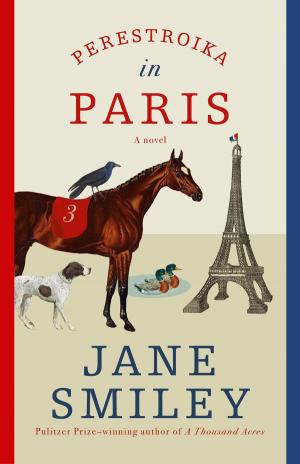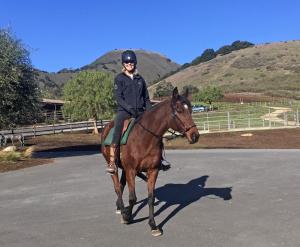Review by Nancy Brannon
Perestroika – that’s a word we haven’t heard since the Mikhail Gorbachev era in the 1980s. It literally means restructuring or reforming the economic and political system. But in Jane Smiley’s 31st book, published in December 2020, Perestroika, aka “Paras,” is the name of a Thoroughbred racehorse who lives just outside Paris. One night, the spirited and curious filly finds her stall door open, walks out, and wanders her way into the city.
“Born of a whim during a visit to Paris over a decade ago, this book ‘was entirely a fantasy,’ said Ms. Smiley, 71. She hopes it offers ‘a distraction’ to all the stress of 2020.
I asked Jane Smiley how she came to use the name Perestroika in the title. She answered, “That is Paras’s official name. Her sire is Moscow Ballet. I liked the sound of it.” The Thoroughbred character in the book is patterned from her own horse – Paras.
She describes Paras as “an interesting and idiosyncratic horse (very curious). I thought she might be the one to escape.” Smiley told me that she has “two [horses] that I bred, Paras and Ned (see my YA series about Ellen and Ned – the first one is called Riding Lessons) and one that I have taken over from his previous owner, Frankie.” Her horses “live at boarding establishments in our area.” Smiley rides “sort of dressage, but nothing fancy,” she says. “I used to jump (and so did they).”
Emily Bobrow, in The Wall Street Journal, writes about author Jane Smiley’s relationship with horses: “Every horse, she explains, has its own fascinating personality, its own idiosyncratic way of being in the world. It just comes naturally to me to give them a point of view.”
You will meet some interesting characters in this book, all living around Paris’ Champs de Mars. If you haven’t been to Paris, you will find the illustrated map on the inside book cover helpful, as you follow the roaming of the various animals in their assembled “group.” And you will read French phrases throughout the book, so if you have not learned the language, keep your dictionary handy.
There’s Paras the horse, of course, who first meets Frida, a German shorthaired pointer who has been left on her own when her homeless human caretaker, Jacques, dies. Then she meets Raoul the raven – ahem, Sir Raoul Corvus Corax, the twenty-third of that name, who lives on the Rue Benjamin-Franklin, speaks seven languages, knows all about a variety of animals including their Latin names, and definitely has a bird’s-eye view of the larger scheme of things. There are the Mallards Sid and Nancy, living on the north pond at the Champ de Mars.
You may wonder how animals on their own, especially horses who have only known the care and feeding from humans and being housed in a cozy stall, can manage to find sufficient food to sustain them. Fortunately, there are several humans in the area who willingly give food to them, plus the dog and raven are good at cleaning up the scraps that people leave behind. But most importantly, Paras left the stable with her groom’s purse, with quite a bit of money inside. Since Frida has experience buying food for Jacques, she takes a bit of money to the butcher and the greengrocer, buying food for herself and Paras.
One morning Frida encounters a young boy, Ä–tienne (8), who cares for his great-grandmother, who is not quite yet 100 years old, but she is blind and deaf – Madame Ä–veline de Mornay. It is not long until Paras and Raoul meet the boy, and Paras eventually makes her way into his house, into the grand salon. It is in Madame de Mornay’s house that we meet the two black, fat rats: father and son Conrad and Kurt. The rats are very good at cleaning up crumbs and left-over food around the house.
Frida had learned from Jacques the tradition of Christmas gift giving (and receiving), so in the week before Christmas, she goes to Jérôme a shopkeeper to purchase several offerings for Ä–tienne and Paras, and gets a ball for herself. “Ä–tienne took Paras straight to the cuisine (French for kitchen), where he had filled her bowl with apples, carrots, and a pear. He petted her on the neck, rested his head against her shoulder. He seemed happier than Paras had ever seen him. Over and over, he said, “Merry Christmas, my dear. What a Merry Christmas this one is!”
The New Year brings changes for this little band of diverse animal friends, even as they grow closer together, along with their supporting cast of humans who feed them and enjoy their company. Smiley teaches us to listen to and respect different points of view, as represented by the various animals. And she helps us understand the longing for freedom and not being confined, as we humans who are so used to being confined in our buildings find hard to understand. The novel celebrates curiosity, ingenuity, and the desire of all creatures for true love and freedom.
Bobrow summarizes the book well: “Ostensibly set in the 21st century, this meringue of a novel (an interesting turn of phrase) is wholesomely timeless, full of good intentions and happy endings that feel far removed from the problems of the moment.”
Find more about author Jane Smiley at Penguin Random House: www.penguinrandomhouse.com/authors/28760/jane-smiley/
Source:
Bobrow, Emily. 2020. “Novelist Jane Smiley Has a Soft Spot for Happy Endings.” The Wall Street Journal. Dec. 4.
Perestroika – that’s a word we haven’t heard since the Mikhail Gorbachev era in the 1980s. It literally means restructuring or reforming the economic and political system. But in Jane Smiley’s 31st book, published in December 2020, Perestroika, aka “Paras,” is the name of a Thoroughbred racehorse who lives just outside Paris. One night, the spirited and curious filly finds her stall door open, walks out, and wanders her way into the city.
“Born of a whim during a visit to Paris over a decade ago, this book ‘was entirely a fantasy,’ said Ms. Smiley, 71. She hopes it offers ‘a distraction’ to all the stress of 2020.
I asked Jane Smiley how she came to use the name Perestroika in the title. She answered, “That is Paras’s official name. Her sire is Moscow Ballet. I liked the sound of it.” The Thoroughbred character in the book is patterned from her own horse – Paras.
She describes Paras as “an interesting and idiosyncratic horse (very curious). I thought she might be the one to escape.” Smiley told me that she has “two [horses] that I bred, Paras and Ned (see my YA series about Ellen and Ned – the first one is called Riding Lessons) and one that I have taken over from his previous owner, Frankie.” Her horses “live at boarding establishments in our area.” Smiley rides “sort of dressage, but nothing fancy,” she says. “I used to jump (and so did they).”
Emily Bobrow, in The Wall Street Journal, writes about author Jane Smiley’s relationship with horses: “Every horse, she explains, has its own fascinating personality, its own idiosyncratic way of being in the world. It just comes naturally to me to give them a point of view.”
You will meet some interesting characters in this book, all living around Paris’ Champs de Mars. If you haven’t been to Paris, you will find the illustrated map on the inside book cover helpful, as you follow the roaming of the various animals in their assembled “group.” And you will read French phrases throughout the book, so if you have not learned the language, keep your dictionary handy.
There’s Paras the horse, of course, who first meets Frida, a German shorthaired pointer who has been left on her own when her homeless human caretaker, Jacques, dies. Then she meets Raoul the raven – ahem, Sir Raoul Corvus Corax, the twenty-third of that name, who lives on the Rue Benjamin-Franklin, speaks seven languages, knows all about a variety of animals including their Latin names, and definitely has a bird’s-eye view of the larger scheme of things. There are the Mallards Sid and Nancy, living on the north pond at the Champ de Mars.
You may wonder how animals on their own, especially horses who have only known the care and feeding from humans and being housed in a cozy stall, can manage to find sufficient food to sustain them. Fortunately, there are several humans in the area who willingly give food to them, plus the dog and raven are good at cleaning up the scraps that people leave behind. But most importantly, Paras left the stable with her groom’s purse, with quite a bit of money inside. Since Frida has experience buying food for Jacques, she takes a bit of money to the butcher and the greengrocer, buying food for herself and Paras.
One morning Frida encounters a young boy, Ä–tienne (8), who cares for his great-grandmother, who is not quite yet 100 years old, but she is blind and deaf – Madame Ä–veline de Mornay. It is not long until Paras and Raoul meet the boy, and Paras eventually makes her way into his house, into the grand salon. It is in Madame de Mornay’s house that we meet the two black, fat rats: father and son Conrad and Kurt. The rats are very good at cleaning up crumbs and left-over food around the house.
Frida had learned from Jacques the tradition of Christmas gift giving (and receiving), so in the week before Christmas, she goes to Jérôme a shopkeeper to purchase several offerings for Ä–tienne and Paras, and gets a ball for herself. “Ä–tienne took Paras straight to the cuisine (French for kitchen), where he had filled her bowl with apples, carrots, and a pear. He petted her on the neck, rested his head against her shoulder. He seemed happier than Paras had ever seen him. Over and over, he said, “Merry Christmas, my dear. What a Merry Christmas this one is!”
The New Year brings changes for this little band of diverse animal friends, even as they grow closer together, along with their supporting cast of humans who feed them and enjoy their company. Smiley teaches us to listen to and respect different points of view, as represented by the various animals. And she helps us understand the longing for freedom and not being confined, as we humans who are so used to being confined in our buildings find hard to understand. The novel celebrates curiosity, ingenuity, and the desire of all creatures for true love and freedom.
Bobrow summarizes the book well: “Ostensibly set in the 21st century, this meringue of a novel (an interesting turn of phrase) is wholesomely timeless, full of good intentions and happy endings that feel far removed from the problems of the moment.”
Find more about author Jane Smiley at Penguin Random House: www.penguinrandomhouse.com/authors/28760/jane-smiley/
Source:
Bobrow, Emily. 2020. “Novelist Jane Smiley Has a Soft Spot for Happy Endings.” The Wall Street Journal. Dec. 4.









